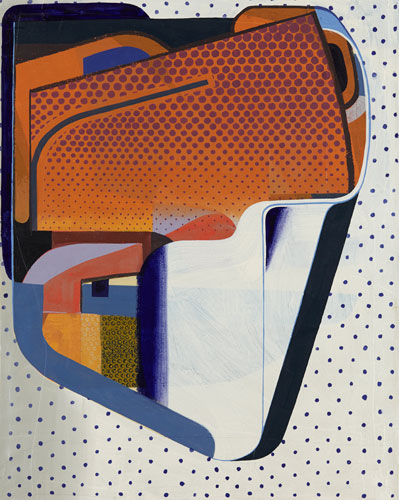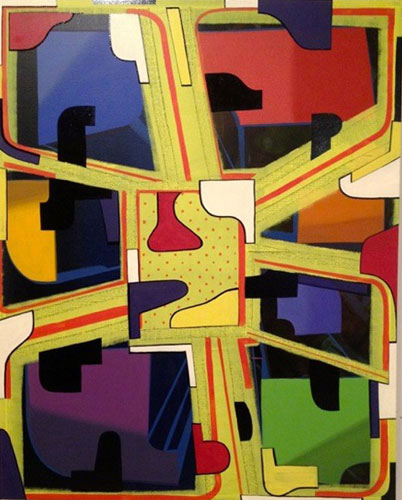
June 9, 2015

Tom Burckhardt, Incognito, 2013
Oil on cast plastic
Courtesy of Tibor de Nagy Gallery

Tom Burckhardt, Avid Antics, 2015
Oil on cast plastic, 40 x 32 inches
Courtesy of Tibor de Nagy Gallery

Tom Burckhardt, Tangential Meditation, 2015
Oil on linen, 60 x 48 inches
Courtesy of Tibor de Nagy Gallery

Tom Burckhardt, The Incredible Think, 2015
Oil on linen, 48 x 60 inches
Courtesy of Tibor de Nagy Gallery
Kid in a Candy Store: Tom Burckhardt and the Provenance of Style
by Drew Lowenstein
Tom Burckhardt: AKA Incognito at Tibor de Nagy Gallery
May 7 to June 13, 2015
724 Fifth Avenue, between 56th and 57th streets
New York City, 212 262 5050
Tom Burckhardt’s recent paintings are very aware of their own provenance. They can be described as a manifestation of a particular strain of locally sourced New York abstract painting. From the 1913 Armory Show to the advent of Abstract Expressionism, American painting was boisterous, mixed and visually complex. Burckhardt gets that, knows the territory, and plunders the treasure. He emerged as a painter in the waning shadow of what had been posited as the death of painting (he graduated SUNY Purchase and Skowhegan in 1986) and in a knowing nod in the direction of painterly doubt, employs cast plastic as a surface support for the smaller paintings here. Previously, his interest in painting as a humorous sculptural object resulted in a delightful “ruckus” of installations informed by life in the studio. His current paintings hang on the wall and seem to say to the viewer, “I know you know I know about doubt, so I’m just gonna keep painting,” which he does with wit, intelligence, and kid-in-the-candy-store joy.
Burckhardt runs an idiosyncratic gamut of biomorphic and cubist geometries, breathing new life into these historic idioms. Incognito is a punchy mash-up of grid and pattern. Burckhardt juggles raucous white, purple and green tones as he flattens, twists and then gives volume to shape into a game of spatial hide-and-seek. As compositional elements of design flip, slide and exchange negative and positive values, our eye is ushered from one unique passage to another. It is as if he is making the case that spatial ambiguity is a kind of gateway drug to new conceptual openings in painting.
Avid Antics looks like Burckhardt flattened a carburetor and proceeded to paint the resulting form. Filling larger forms with incremental detail, he teases out totemic personas reminiscent of the Pacific Northwest Native imagery popular with painters of 1930s and ’40s New York. His mediating line is always live; it carries direction and various potential legibilities that can morph into a descriptive shape or gesture, or empty into a plane. In this case, his design suggests a totemic mask that contains spatially recessive Ben-Day dots that contrast against a uniformly dotted background. Burckhardt’s crisply cut, curvilinear lines, share common cause with those employed by contemporaries Joanna Pousette-Dart and Elliot Green, and extend a New York School tradition. De Kooning’s own late-career summations reconsolidated his precisely cut line and curve, traces of which have rubbed off in a painting here titled Bourgeois Melodies. One can only imagine how Gorky might also have reprised such line had he lived another few decades and created a Summation II.
Tangential Meditation, Burckhardt’s showstopper, seems to pulse to the rhythms of New York City’s physicality. If one were to update Charles Sheeler and Stuart Davis for 2015 this would be the result. Burckhardt overlaid an arterial network that stretches edge to edge on the forefront of the picture plane and functions as a framing device. As in a multi-pictured postcard in a souvenir shop, several portals are revealed that showcase different abstract industrial silhouettes in shades of both dawn’s and dusk’s most arresting colors. Roof vents, air ducts, chimneys are nearly identifiable. The central hub functions as a circuit or axis from which branching arms extend and frame the proceedings, exerting surface tension, syncopation and dynamic spin. A group of smaller shapes that look like migrating stretcher bar keys circulates, punctuating the movement of the viewer’s eye across the surface.
The dominant form in The Incredible Think is a bit like something from a Rorschach test. It could be a geometric cyborg animal in mid-stride, or perhaps a version of Stan Lee’s The Thing caged by the support edge. Consisting of thickly outlined green, yellow and ochre blocks, the viewer is reminded of the boldness of Jonathan Lasker or Nicholas Krushenick. It also makes a timely comparison with Nozkowski’s Untitled (9-34), exhibited last month at Pace Gallery. Neither painter shrinks from agitating Neo-plasticism’s essentials. Nozkowski’s delicately hewn surfaces evoke the careful consideration given to each step of the delicate arrangement of composition, and then genteelly sweep up after themselves. In contrast, Burckhardt explores and builds additional possibilities while letting us in on his process. Burckhardt’s humorous, Gustonian inclusion of a red stretcher bar in the top third of the canvas suggests the back of another painting in the studio. Additionally a smaller painting seems tacked to the top of the stretcher bar and just hangs there, presumably because that sometimes happens in the studio, too. This device welcomes us into the creative world of studio activity beyond “practice.” His painterly versatility and sculptural incursions have expanded the territory of painting.
